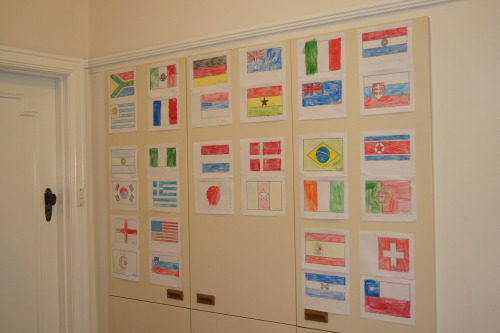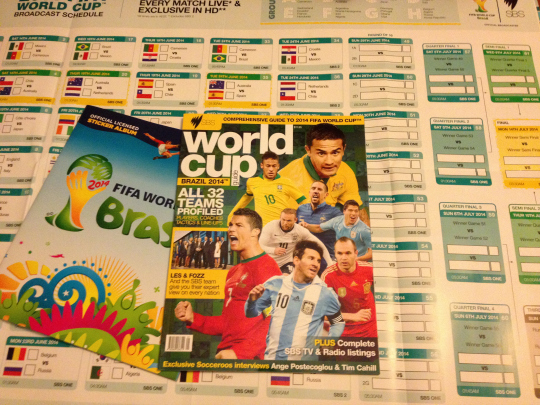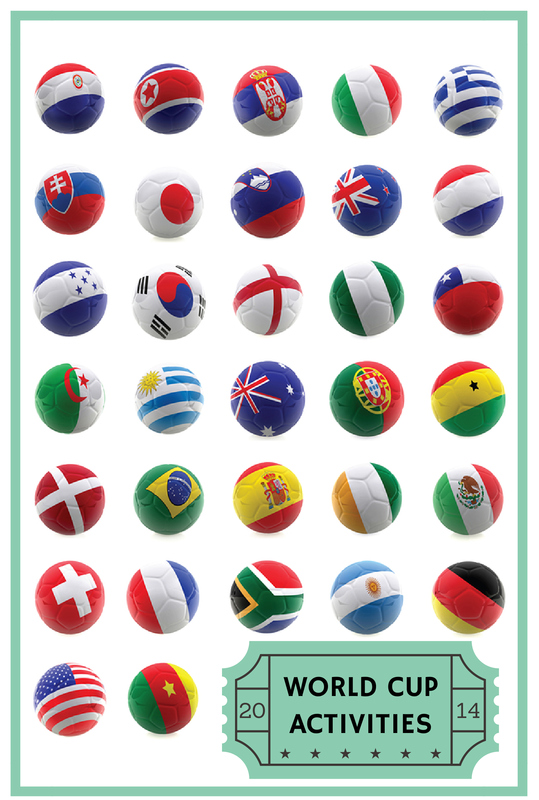If you are looking for activities for the 2018 FIFA World Cup, please click here to go to my latest post.
We first did this activity back in the 2010 FIFA World Cup, which you can see in this post here and I highlight as well as the pure enjoyment of this activity for the kids, there is much they can learn from World Cup activities.
We will spend this long weekend colouring in together and setting up the world cup draw on our kitchen cupboards. I think there will be even more excitement in the house this World Cup as the youngest two have chosen to play football (soccer) rather than Aussie rules.
How the FIFA World Cup draw works
To set up the World Cup draw you will need to have a basic understanding of how the World Cup works, so here is a very quick summary:
- There are 32 teams divided into 8 groups of 4.
- There are two stages: the group stage followed by the knockout stage.
- The group stage involves a series of round robin games within the group, with every team playing three games.
- The top two teams from each group advance to the knockout stage, which is known as the “round of 16”.
- At the round of 16 there are 8 elimination games played.
- The winners of the 8 games go through to the quarter finals, where there are 4 matches.
- The winners of those games go through to the semi-finals, where there are 2 matches.
- The remaining 2 teams then play out in the World Cup Final.
FIFA World Cup flags

The photo above shows a previous World Cup activity we have done. To set up this activity for the kids at home here is how it works:
- Print out the flags of all 32 participating countries. Have the kids colour the flags in the right colours.
- We set them up in 8 groups of 4 flags. All flags will remain on the cupboards until the end of the group stage.
- Once we know which countries didn’t make it through to the round of 16, we will take their flags down.
- The teams that are eliminated in the knock out stage are then removed and we will be left with only 8 flags.
- At the end of the quarter finals another 4 will be removed.
- Then after the semi- finals it will be down to the last two, then of course only the winner is remaining.
Once we have set the draw up in the kitchen, we then write the names of all the teams and Mr I sorts them into groups based on their likely hood to make it through to the finals. We all then are allocated a number of teams for the World Cup, receiving a mix of teams with a decent chance and those who are unlikely to make it past the group stage.
We have a prize for the people who have the teams that make it to the final. The person who has the winner of the World Cup is allowed to choose a family take away meal. The person who has the team which lost in the final is allowed to choose the dessert.
We have a great time doing this and it is an activity that everyone can join in and enjoy. Even if there team doesn’t make it to the final they still get to have a takeaway dinner which doesn’t happen very often in our house so is quite exciting!
The table below has all the teams in the 2014 FIFA World Cup set out in their groups. You can click on the links and go through to a picture of that country’s flag, which you can print out and colour in.
GROUP A | GROUP B | GROUP C | GROUP D |
| Brazil Croatia Mexico Cameroon | Spain Netherlands Chile Australia | Colombia Greece Côte D'Ivoire Japan | Uruguay Cost Rica England Italy |
GROUP E | GROUP F | GROUP G | GROUP H |
| Switzerland Ecuador France Honduras | Argentina Bosnia & Hercegovina Iran Nigeria | Germany Portugal Ghana USA | Belgium Algeria Russia Korea Republic |
More FIFA World Cup activities and resources
There are so many activities you can do with the FIFA World Cup to leverage their enthusiasm for natural learning opportunities.
National Literacy Trust
The National Literacy Trust in the UK has created Love Football: Love Reading 2014 which is an amazing resource:
The World Cup toolkit aims to hook young people and especially boys into reading by focusing on the events and highlights of the tournament as they happen. National Literacy Trust research in 2012 revealed that 3 out of 4 (76%) UK schools were concerned about boys’ underachievement in reading and an estimated 60,000 boys failed to reach the expected level in reading at age 11.
I think Australia would be quite similar to this as well. It would be great to see something like this for Aussie rules as this is the dominate football code in my part of the world. My boys do however love soccer, so we will be using these resources especially:
- World Cup Children’s Book Bingo
- World Cup comprehension activities (will be online from June 9)
ESOL Courses
ESOL Courses is a site which teaches English as a second language, but they have an extensive list of online and printable activities that would suit varying ages.
Activity Village UK
The activities on Activity Village UK are more suited to younger kids and they have loads of fun free things to print out and do like:
If you are short on time you can pay £3.95 to download them all at once here.
SBS Comprehensive Guide to 2014 FIFA World Cup (Magazine)
 This is one for Australians, SBS is the World Cup broadcaster and they have a great magazine which you can pick up either online here or at newsagents for $11.95. It has profiles on all of the teams, interviews and opinions, but the biggest win with us was the wall chart which tells you what time each game is being televised and on which channel.
This is one for Australians, SBS is the World Cup broadcaster and they have a great magazine which you can pick up either online here or at newsagents for $11.95. It has profiles on all of the teams, interviews and opinions, but the biggest win with us was the wall chart which tells you what time each game is being televised and on which channel.
Fixture
You can find the complete fixture here which has dates and times of all the matches – FIFA World Cup Match Schedule 2014
Go the Socceroos!

